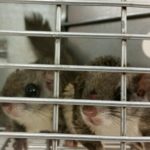 These Flying Squirrels may appear calm and tame in our cage, however, when they were running loose in the attic; it was a totally different story. The most common comment we hear in this situation is, “It sounds like there is a bowling league in the attic every night.”
These Flying Squirrels may appear calm and tame in our cage, however, when they were running loose in the attic; it was a totally different story. The most common comment we hear in this situation is, “It sounds like there is a bowling league in the attic every night.”
Although Flying Squirrels don’t in fact “fly”, they can glide for distances of up to 295 feet. The ability to alter course and speed enables them to pick and hit a target, including homeowners’ rooftops.
Thanks to their agility, small stature and flexible bone structure, Flying Squirrels typically have easy access into an attic from the roof top. Any construction gap of 1 inch is an open door and invitation to a Flying Squirrel.
We are currently in the midst of their mating season which runs February through March. After delivering the young, who are born hairless with internal organs visible through the skin, Mom bares sole responsibility for nurturing duties. (Ladies, in the interest of avoiding marital discord, let’s not make comparisons with our husbands on this topic!)
Flying Squirrels are nocturnal and omnivores. They are active at night feeding on seeds, insects, slugs and snails, spiders and vegetation to name a few diet choices. Because they are nocturnal, a homeowner may not be aware a feast is taking place nightly in their yard.
As with so many other pests, one step in preventing a Flying Squirrel problem is to make the yard as inhospitable as possible. Because seeds are a tasty treat for Flying Squirrels, as well as many other nocturnal pests, all bird feeders should be empty in the evening. Outdoor pet food dishes should also be empty, and trash cans should be fitted with locking lids.
If you should experience a problem with Flying Squirrels, or any other pest control issue, please contact Mr. Bugg’s Pest Patrol for an evaluation today.

